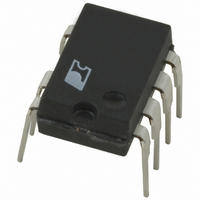TNY266PN Power Integrations, TNY266PN Datasheet - Page 3

TNY266PN
Manufacturer Part Number
TNY266PN
Description
IC OFFLINE SWIT OTP OCP HV 8DIP
Manufacturer
Power Integrations
Series
TinySwitch®-IIr
Specifications of TNY266PN
Output Isolation
Isolated
Frequency Range
124 ~ 140kHz
Voltage - Output
700V
Power (watts)
15W
Operating Temperature
-40°C ~ 150°C
Package / Case
8-DIP (0.300", 7.62mm), 7 Leads
Output Voltage
5.8 V
Input / Supply Voltage (max)
265 VAC
Input / Supply Voltage (min)
85 VAC
Duty Cycle (max)
68 %
Switching Frequency
132 KHz
Supply Current
265 uA
Operating Temperature Range
- 40 C to + 150 C
Mounting Style
Through Hole
Supply Voltage
265VAC
Digital Ic Case Style
DIP
No. Of Pins
8
No. Of Regulated Outputs
1
Filter Terminals
DIP
Rohs Compliant
Yes
On Resistance Rds(on)
14ohm
Lead Free Status / RoHS Status
Lead free / RoHS Compliant
Other names
596-1051-5
Available stocks
Company
Part Number
Manufacturer
Quantity
Price
Company:
Part Number:
TNY266PN
Manufacturer:
PHILIPS
Quantity:
3 000
Company:
Part Number:
TNY266PN
Manufacturer:
PowerInt
Quantity:
84 450
Part Number:
TNY266PN
Manufacturer:
POWER
Quantity:
20 000
TinySwitch-II Functional Description
TinySwitch-II combines a high voltage power MOSFET switch
with a power supply controller in one device. Unlike conventional
PWM (pulse width modulator) controllers, TinySwitch-II uses
a simple ON/OFF control to regulate the output voltage.
The TinySwitch-II controller consists of an oscillator,
enable circuit (sense and logic), current limit state machine,
5.8 V regulator, BYPASS pin under-voltage circuit, over-
temperature protection, current limit circuit, leading edge
blanking and a 700 V power MOSFET. TinySwitch-II
incorporates additional circuitry for line under-voltage sense,
auto-restart and frequency jitter. Figure 2 shows the functional
block diagram with the most important features.
Oscillator
The typical oscillator frequency is internally set to an average
of 132 kHz. Two signals are generated from the oscillator: the
maximum duty cycle signal (DC
indicates the beginning of each cycle.
The TinySwitch-II oscillator incorporates circuitry that
introduces a small amount of frequency jitter, typically 8 kHz
peak-to-peak, to minimize EMI emission. The modulation rate
of the frequency jitter is set to 1 kHz to optimize EMI reduction
for both average and quasi-peak emissions. The frequency jitter
should be measured with the oscilloscope triggered at the falling
edge of the DRAIN waveform. The waveform in Figure 4
illustrates the frequency jitter of the TinySwitch-II.
Enable Input and Current Limit State Machine
The enable input circuit at the EN/UV pin consists of a low
impedance source follower output set at 1.0 V. The current
through the source follower is limited to 240 µA. When the
current out of this pin exceeds 240 µA, a low logic level
600
500
400
300
200
100
Figure 4. Frequency Jitter.
0
0
Time (µs)
136 kHz
128 kHz
V
DRAIN
5
MAX
) and the clock signal that
10
(disable) is generated at the output of the enable circuit. This
enable circuit output is sampled at the beginning of each
cycle on the rising edge of the clock signal. If high, the power
MOSFET is turned on for that cycle (enabled). If low, the power
MOSFET remains off (disabled). Since the sampling is done
only at the beginning of each cycle, subsequent changes in the
EN/UV pin voltage or current during the remainder of the
cycle are ignored.
The current limit state machine reduces the current limit by
discrete amounts at light loads when TinySwitch-II is likely to
switch in the audible frequency range. The lower current limit
raises the effective switching frequency above the audio range
and reduces the transformer flux density, including the associated
audible noise. The state machine monitors the sequence of
EN/UV pin voltage levels to determine the load condition and
adjusts the current limit level accordingly in discrete amounts.
Under most operating conditions (except when close to no-load),
the low impedance of the source follower keeps the voltage on
the EN/UV pin from going much below 1.0 V in the disabled
state. This improves the response time of the optocoupler that
is usually connected to this pin.
5.8 V Regulator and 6.3 V Shunt Voltage Clamp
The 5.8 V regulator charges the bypass capacitor connected to
the BYPASS pin to 5.8 V by drawing a current from the voltage
on the DRAIN pin whenever the MOSFET is off. The BYPASS
pin is the internal supply voltage node for the TinySwitch-II.
When the MOSFET is on, the TinySwitch-II operates from the
energy stored in the bypass capacitor. Extremely low power
consumption of the internal circuitry allows TinySwitch-II to
operate continuously from current it takes from the DRAIN
pin. A bypass capacitor value of 0.1 µF is sufficient for both
high frequency decoupling and energy storage.
In addition, there is a 6.3 V shunt regulator clamping the
BYPASS pin at 6.3 V when current is provided to the BYPASS
pin through an external resistor. This facilitates powering of
TinySwitch-II externally through a bias winding to decrease the
no-load consumption to about 50 mW.
BYPASS Pin Under-Voltage
The BYPASS pin under-voltage circuitry disables the power
MOSFET when the BYPASS pin voltage drops below 4.8 V.
Once the BYPASS pin voltage drops below 4.8 V, it must rise
back to 5.8 V to enable (turn-on) the power MOSFET.
Over Temperature Protection
The thermal shutdown circuitry senses the die temperature. The
threshold is typically set at 135 °C with 70 °C hysteresis. When
the die temperature rises above this threshold the power MOSFET
is disabled and remains disabled until the die temperature falls
by 70 °C, at which point it is re-enabled. A large hysteresis of
TNY263-268
4/05
G
3













